Potato
![]()
This article is about the crop plant. For the colloquial name for Germans, see potato (slang).
The potato (Solanum tuberosum), also known in parts of Germany, Austria and Switzerland as Erdapfel, Erdbirne, Grundbirne, Bauerntrüffel, Potaten (only in the plural) and other regional names, is a crop plant from the nightshade family (Solanaceae). In common parlance, potatoes usually refer to the tubers growing in the soil, with which the plant reproduces vegetatively.
The word potato (in the 17th century still tartuffel) is derived from tartufolo, the Italian word for truffle, which in turn is derived from Latin terrae tuber ("earth tuber"). The only distantly related sweet potato (Ipomoea batatas) got its name because of the similar use and appearance of the tubers.
The seeds are formed in tomato-like berries, which, like all the green parts of the plant and the germs of the tuber, are slightly poisonous to humans.
Around 376 million tonnes of potatoes are harvested worldwide every year. The potato is one of the world's most important foodstuffs, but it is also used as animal feed and an industrial raw material.
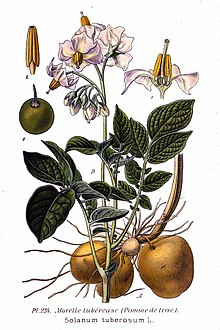
Illustration
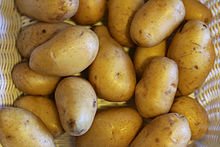
Potatoes (Nicola variety)
Description
Appearance and leaf
Potatoes are upright or climbing perennial herbaceous plants that can reach heights of over 1 meter. The shoot axis is sometimes square, sometimes even winged. Underground or just above the surface, the plant forms tuberous stolons.
The alternate stem leaves are divided into a short petiole and a leaf blade. The imparipinnate leaf blade is 10 to 30 centimetres long and 5 to 15 centimetres wide. The opposite or alternate leaf segments are slightly to very hairy, often of varying shape and size. The larger partial leaves are partly stalked and, with a length of 2 to 10 centimetres and a width of 1 to 6 centimetres, are ovate to oblong-ovate with a somewhat heart-shaped base and a pointed to acuminate upper end. The smaller subleaves are broad-ovate to circular with a diameter of 2 to 15 millimeters and have a base that is more cordate, a blunter upper end. The partial leaves are more or less densely downy hairy.
Inflorescence and flower
The flowers are in umbellate inflorescences. The inflorescence stems are 5 to 15 centimeters long and hairy. The flower stalks are also hairy and 3 to 35 millimeters long.
The hermaphrodite flowers are radially symmetrical and five-celled with a double perianth. The calyx is bell-shaped and five-lobed with a diameter of 1.5 to 2 centimetres. The calyx lobes are pointed to strongly acuminate. The petals are white to blue, the corolla is twice as long as the calyx and 3.5 to 4 centimeters in diameter. The yellow anthers are free, erect and porous.
Fruit and seed
The fruit is a yellowish-green, two-chambered berry with many seeds, which is not suitable for human consumption due to the solanine it contains.
· .jpg)
Habitus
· 
Feathered leaf
· 
Blossoms
· 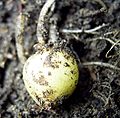
Young tuber on stolo
· 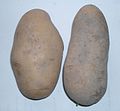
Potato Tubers
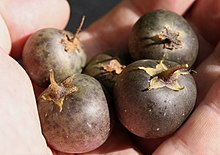
Fruits of the potato plant
Ontogenesis
Germination takes place epigaeically. At the beginning, only the root system and the hypocotyl emerge from the seed coat, while the cotyledons initially remain within it. Only later do they also leave the seed coat, turn green and become the first assimilation organs. The initially formed primary leaves are even simpler in construction than the later pinnate subsequent leaves.
Axillary buds sprout from the basal parts of the shoot, penetrate the soil and continue to grow horizontally (plagiotropic) stolons. Instead of deciduous leaves, they bear scale leaves. The ends of these stolons thicken and transform into the tubers. This is a primary growth of thickness. Thus, they are shoot tubers. The tuber has only small scale-like leaves, but they are decumbent, so they fall off early. In the axils of the leaf scars are the buds (here called eyes), from which the tuber sprouts again after the dormant period. The tuber is polar differentiated: The base, the end facing the parent plant, is called the umbilical end. It is the point of attachment of the stolon, which dies after the tuber has matured. At the tip, the terminal bud sits in a pit-like depression. On resprouting, the terminal bud grows out preferentially, which then grows vertically (orthotropically) to form an aerial shoot.
The green parts of the potato contain a concentration of alkaloids, including solanine, which form a natural defense barrier against bacteria and insects, for example. For this reason, potatoes which have turned green when stored in the light are no longer edible.

Lower part of a plant. The mother tuber is dark marked.
Questions and Answers
Q: What is a potato?
A: A potato is a vegetable, the Solanum tuberosum.
Q: What part of the potato do people eat?
A: The part of the potato that people eat is a tuber that grows under the ground.
Q: What does a potato contain?
A: A potato contains a lot of starch and other carbohydrates.
Q: What does a potato usually look like?
A: Potato usually has a light-brown or yellowish skin and is white or yellow inside.
Q: What happens to a potato if it gets light on it?
A: If the potato gets light on it, the tuber turns green and will be poisonous.
Q: What type of plant is a potato?
A: A potato is a small plant with large leaves.
Q: Is a green potato safe to eat?
A: No, a green potato is poisonous and should not be consumed.
Search within the encyclopedia